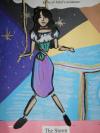Project Navigation |
View Galleries:
View Related Projects:

|

Shakespeare's Comedies & the Mythos of Spring: Archetypal Criticism
|
Project Folio |
Title
Shakespeare's Comedies & the Mythos of Spring: Archetypal CriticismCollaborators
Cindy YeungSchools
Lord Byng SecondaryLanguages
EnglishGrades
English 9 (Literary Arts)Last Modified
April 30, 2007Description
In an enriched English 9 class (Literary Arts specialization in the Byng Arts program), students explored archetypes in Shakespeare's comedies. We started by looking at different ways in which Shakespeare's comedies have been "classified" (e.g., tragicomedies, romances, "problem plays"). Students then worked in groups of three, selecting one of the comedies to present. After an introduction to key concepts in Northrop Frye's _Anatomy of Criticism_ (The Mythos of Spring) and Joseph Campbell's _The Hero with a Thousand Faces_, students identified at least ten ways in which Frye's comedy archetypes applied to their selected play (or, if they differed, how so). Students also explored three symbols from the play.Galleries |
 |
The Tempest Poster by Polina, Sine, and Wade: Comedy archetypes in Shakespeare's _The Tempest_. Note the visual arrangement of the poster: Prospero is the master puppeteer pulling the strings of the play's events.View Gallery |
 |
As You Like It Installation by Lee, Marchel, and Nico: Tree in the Forest of Arden -- 3-D presentation of comedy archetypes. This motif was inspired by the image of Orlando hanging his love poem to Rosalind from a tree.View Gallery |
Related Projects |
Comments |